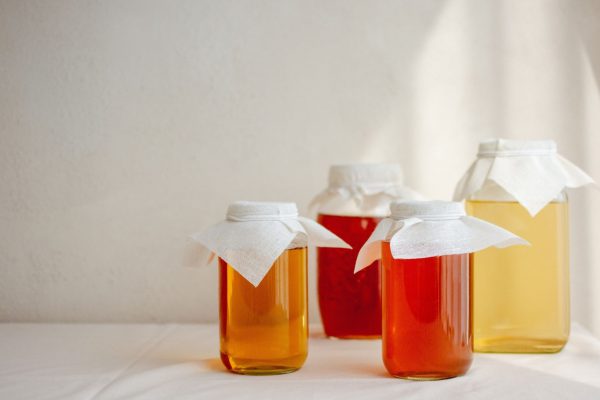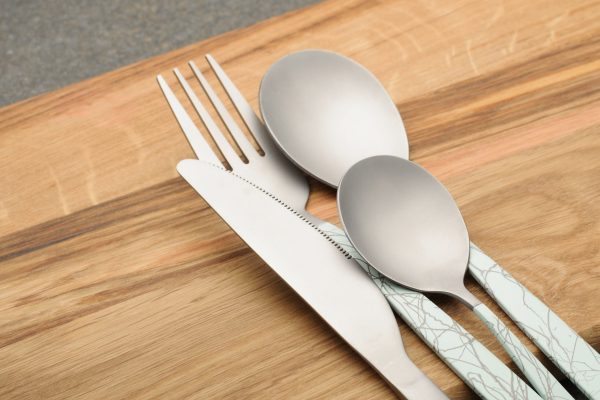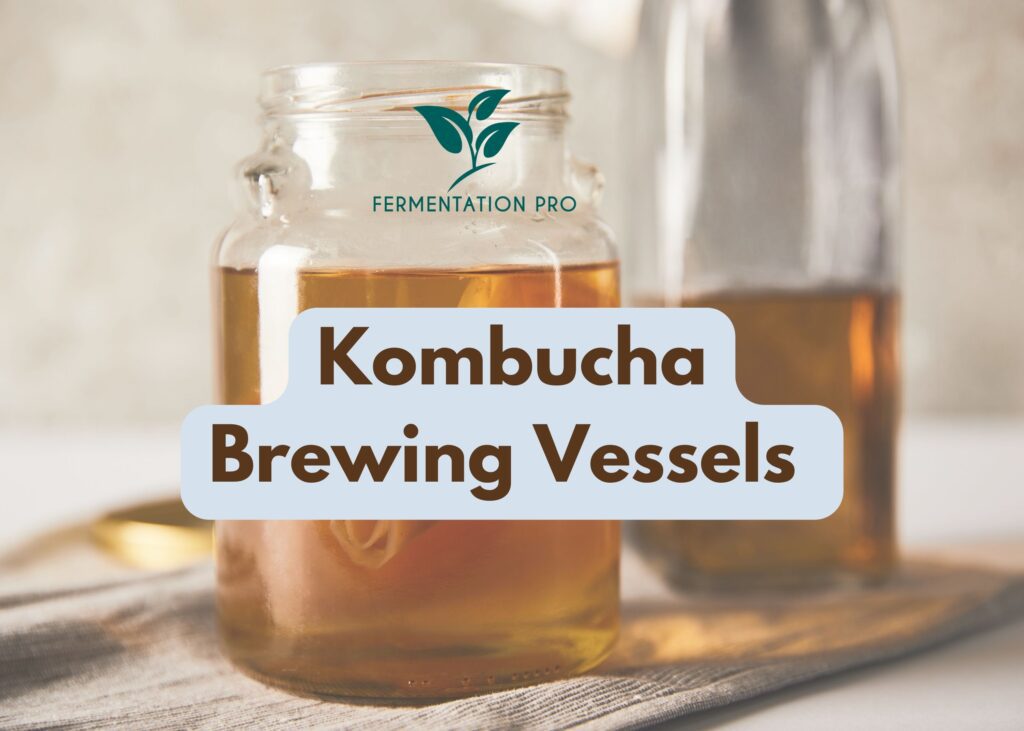If you’ve been interested in Kombucha brewing, you have probably already made your first steps toward knowing about what kombucha brewing vessels to use. However, if you haven’t done your initial research and are still completely clueless, don’t worry because we got your back. Today, we will be taking you through everything you should know about Kombucha brewing vessels so you can brew your Kombucha safely and successfully.
When it comes to Kombucha brewing vessels for first fermentation, the best vessel to use is glass. You may also use ceramic as long as it’s food-grade and not glazed with any paint that could leach in your brew. In addition to those, food-grade stainless steel, grade 304 and higher is another excellent option for brewing Kombucha.
Table of Contents
Kombucha Brewing Vessels
Kombucha brewing vessels come in different materials, sizes, appearances, and shapes nowadays. The truth is it can be difficult to decide which brewing vessel to get. Hence, we made this special guide that gives you complete detail about what brewing vessels to get and what to avoid.
Best Materials for Kombucha Brewing Vessels

- Glass
Kombucha brewing vessels made with glass remain to be a go-to choice for many homebrewers. Unlike other materials, glass doesn’t react to the acidity of Kombucha and doesn’t leach any chemicals like BPA that can affect your brew’s quality or your health. In addition, they are reusable and transparent so you can easily monitor your brew for any molds without having to open the vessel. Moreover, they are easy to find in many leading retailers and online shops at a reasonable price. On the downside, they are prone to breaking due to an impact so careful handling is required.
- Ceramic
Like glass, ceramic is also a great material for brewing vessels because it is stable and does not affect fermentation negatively. They are also BPA-free so you won’t have to worry about any toxic chemicals leaching into your brew. However, before you buy ceramic brewing vessels intended for Kombucha brewing, make sure that the vessel is food grade and is not glazed with paint that can affect the fermentation process.
Compared to glass, ceramic brewing vessels are less common and are more expensive. In addition, they are not transparent so you need to open your Kombucha every now and then to check for any molds. They are also prone to breaking due to impact so you’ll need to handle them with care.
- Food-grade stainless steel
Food-grade stainless steel, grade 304 or higher, is a corrosive-resistant metal that does not leach when it gets into contact with highly acidic drinks like Kombucha. It is safe to use and doesn’t affect the flavor of Kombucha in any way. However, stainless steel brewing vessels do come with disadvantages too. Stainless steel brewing vessels are not transparent so you will not be able to monitor your brew from the outside. In addition, stainless steel brewing vessels for homebrewing are relatively rare and can cost higher than glass. On a lighter note, stainless steel is not prone to breaking and can last for a long time.
What Materials To Avoid When Looking For Kombucha Brewing Vessels
- Plastic
While an extremely useful material in cookware, appliances, and more essential items, there are better materials than plastic when looking for Kombucha brewing vessels. Plastic contains BPA, a synthetic compound commonly found in plastics that adversely affects the brain and causes other health issues. When plastic gets into contact with acidic substances like Kombucha, it can leach chemicals like BPA and contaminate your brew and make it unsafe for consumption.
Although some brewers use plastic bottles for Kombucha’s second fermentation, using plastic brewing vessels for the first fermentation is not a good idea. Compared to the second fermentation, the first fermentation takes a longer time. This time is enough for the plastic brewing vessel to leach. In addition to that, the acidity level of Kombucha is higher during the first fermentation than second fermentation. The high acidity can cause the plastic to leach faster.
- Metal
Metal materials other than stainless steel can leach toxins when exposed to highly acidic substances such as Kombucha for a long time. Although, metal containers do last a long time and are unbreakable, using them will just increase the risk of contamination and may even cause a number of health issues.
Size of Kombucha Brewing Vessels
As we have said above, Kombucha brewing vessels now come in different sizes according to your need. When deciding what size of brewing vessel to get, we suggest only using the right size. Do not use a brewing vessel that is too small or too big.
A very small brewing vessel may not provide adequate surface area to circulate oxygen for your Kombucha brew. Without oxygen, the Kombucha culture will not be able to convert the alcohol in Kombucha to acetic acid, the substance that gives Kombucha its tart flavor. On the other hand, using a Kombucha brewing vessel that is too big can make the fermentation process longer and can even affect the taste of your finished Kombucha.
Clear Or Opaque Kombucha Brewing Vessels
Clear brewing vessels always hold an advantage compared to opaque ones. Opting for clear Kombucha brewing vessels allows you to monitor your brew for any molds and check the fermentation progress. This prevents you from opening the brew often which may allow insects and other contaminants to enter the brew.
However, clear Kombucha brewing vessels are not perfect. Transparent materials can let the light pass through which is not ideal for Kombucha as direct light causes the yeast to slow down and stop fermentation. So, if you’re using clear Kombucha brewing vessels, remember to keep them in a dark place or use a Kombucha sleeve to prevent the light from passing through.
Best Shape of Kombucha Brewing Vessels
It is important to take note of the shape of the brewing vessels as it can affect the fermentation speed. Essentially, the more surface area a brewing vessel has the more oxygen can circulate in the brew. With more oxygen, the yeasts can boost fermentation and shorten the time for fermentation. This makes Kombucha in short vessels with wide openings ferment faster. On the other hand, tall brewing vessels with a narrow openings can lessen the amount of oxygen in the brew and make fermentation time longer.
So, should you get a short vessel with the widest surface area? Our advice is to get a vessel that has a moderate surface area. While it’s true that vessels with a wide surface area can brew faster, it can also make your brew turn sour quicker. Hence, it is best to opt for vessels with moderate size to allow your brew to ferment evenly at a good pace.

What Is The Best Container To Brew Kombucha In?
Glass brewing vessels are the best and safest choice when it comes to Kombucha brewing vessels. These containers are BPA-free and are not likely to leach any harmful toxins that can cause Kombucha to have a weird taste or potential health risks. Glass brewing vessels are also clear so you can monitor your brew whenever you want without lifting the lid. In addition, they are widely available in many leading retailers and online shops at a budget-friendly purchase price. They are reusable as well making them an environment-friendly choice.
Can I Use Metal Utensils For Kombucha?

The answer is yes. Many new homebrewers get afraid of using metal utensils but the truth is, it is safe to use them for Kombucha. Using a metal spoon, knife, strainer, or other metal utensils in your Kombucha brew or SCOBY is safe as long as the exposure is only brief. Short exposure to Kombucha is not enough time for metal to leach. However, before you use these utensils make sure to clean them first thoroughly or wash them with Kombucha liquid to prevent any microorganisms from entering your brew.
Why Should You Not Use Metal With Kombucha?
Metals other than steel are prone to leaching toxins when exposed to highly acidic substances like Kombucha for a long period of time. When these toxins get into your brew, they could affect the taste of your finished Kombucha and even damage your SCOBY. In addition to that, the finished Kombucha may not be suitable for consumption. The most common metals that leach due to acidity are:
- Aluminum
- Brass
- Cast Iron
- Low-grade stainless steel
Can I Use Plastic Container For Kombucha?
Plastic is not a recommended material for containing Kombucha that is undergoing first fermentation. This is because Kombucha tends to have more acidity during the first fermentation causing the plastic to leach faster. In addition, the duration of fermentation is longer. The longer exposure of plastic to the acidity of Kombucha can cause it to leach.
The only time you can use a plastic container for Kombucha is during the second fermentation as the Kombucha’s acidity is likely to have gone down to safer levels. In addition to that, the second fermentation takes a shorter time than the first fermentation.
Can Kombucha Go In Stainless Steel?
The short answer is yes. As we have discussed above, unlike other types of metals, stainless steel does not leach toxins and is safe to use for brewing Kombucha. Just make sure to use stainless steel grade 304 or higher to ensure the quality of the vessel. Steels with lower grades indicate lower quality and can leach toxins when exposed to Kombucha acidity.








